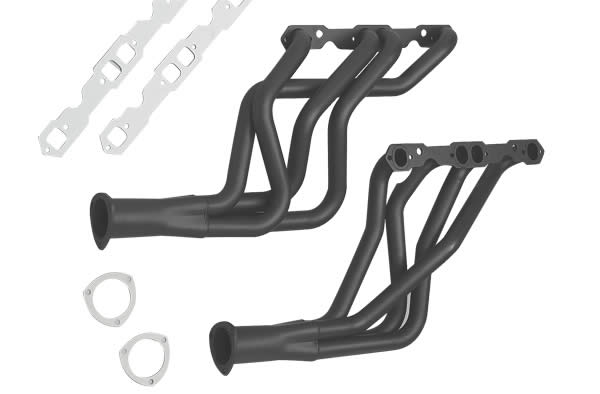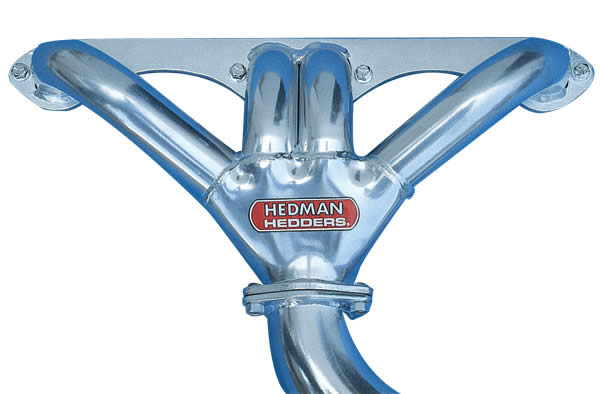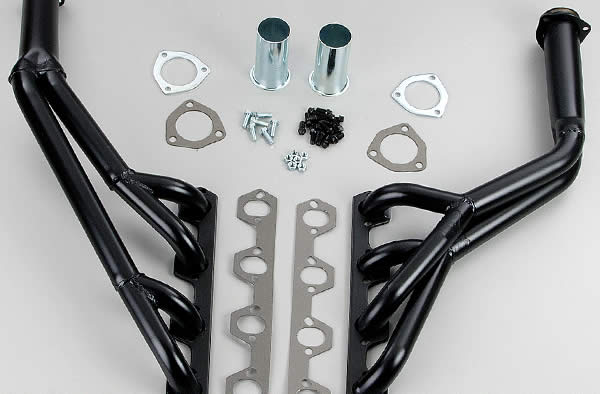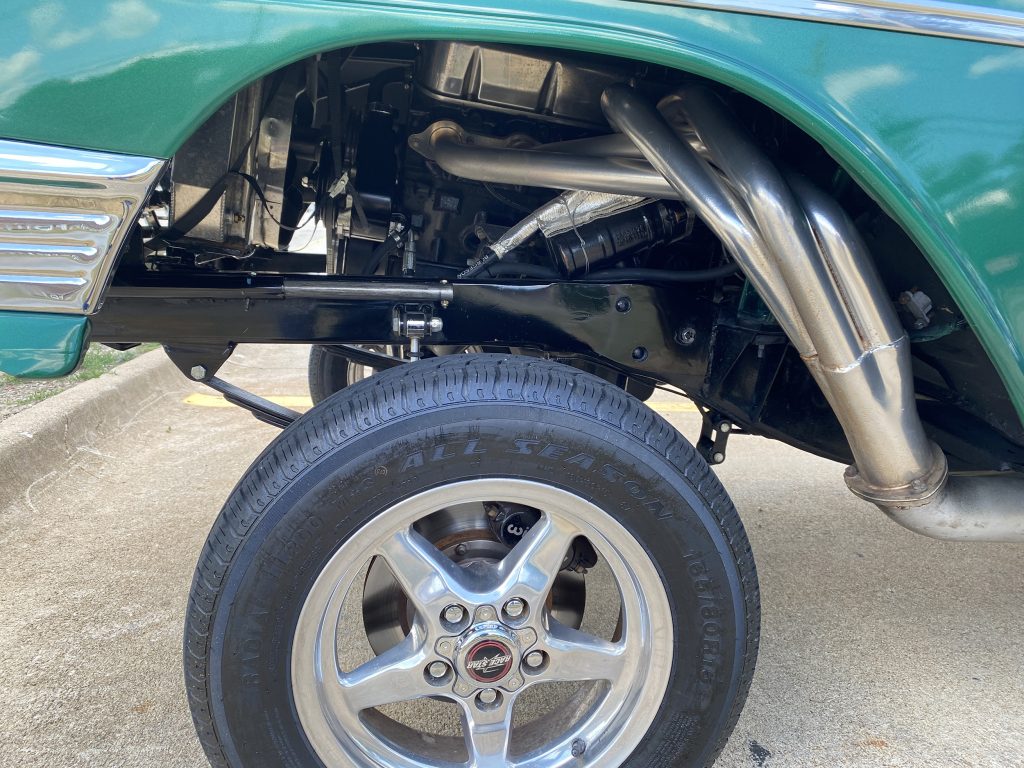Stock exhaust systems typically restrict the flow of exhaust gases out of your engine, and thus prevent your engine from reaching its full power potential. In our “Exhaustive Research” post, we showed you how to choose the right exhaust system to help gain back lost horsepower.
Of course, the first exhaust components to handle spent exhaust gases from your engine are the exhaust manifolds or headers. The stock manifolds are restrictive, but a set of mandrel-bent aftermarket headers will allow the exhaust gas to move freely from the engine, reducing power-robbing backpressure in the process and allowing your exhaust system to expel gases even more efficiently. A good set of headers will actually build up enough exhaust flow velocity to create energy pulses that pull or scavenge spent gases from the engine.
So what makes a good header for your application? Consider these five points:
5 Things to Consider When Buying Exhaust Headers
***
1. Header Size: Bigger Isn’t Always Better
One of the main considerations in choosing a set of headers is the diameter of the primaries, which are the pipes that connect directly to the exhaust ports. There are many factors that go into choosing the right pipe diameter—engine size, horsepower, intended use of the vehicle, and more—but one common mistake that many hot rodders make is to assume bigger is better.
Although smaller-diameter primaries will flow less volume than bigger primaries, a smaller diameter pipe actually creates faster exhaust flow velocity with just enough resistance to foster good low- and midrange torque. For that reason, most header manufacturers recommend modest pipe diameters for street applications—1 ½-inch to 1 5/8-inch diameter primaries for a small block engine, for example.
***
2. Header Dimensions: Full Length vs. Shorty
Headers come in a variety of dimensions and configurations for specialty applications, including fenderwell, dragster, and circle track headers. We’ll keep our focus on the most common street performance designs: full-length, shorty, and mid-length.

Full-length headers utilize primary tubes that are longer than the primaries on your stock exhaust manifold. In most cases, these four primary tubes empty into one collector pipe and form a “4-1” design. Full-length headers help produce more overall power with good power in the low- and mid-rpm ranges—right where most street-driven vehicles can use it the most! The longer primaries also reduce the chance of escaping gases getting drawn back into another pipe.

Shorty headers consist of four short primaries that dump into one short collector pipe. The compact dimensions make shorty headers a perfect choice for extremely crowded engine compartments or lowered vehicles where clearance is a concern. Shorty headers also typically work with the remaining stock exhaust components without modification (full-length headers require some modifications), so installation is often a quick, clean process. Although shorty headers don’t always produce as much low- and mid-range power as full-length headers, they do provide significant power gains over stock manifolds and have the potential to produce higher rpm power gains.
You can maximize the performance of your shorty headers by opting for equal-length primaries. Equal-length primaries will scavenge gases equally from all eight cylinders, keeping the torque curve consistent from each cylinder. The result is a broader torque curve in the low- and mid-rpm range.
Mid-length headers offer some of the benefits of full-length and shorty headers. They provide longer primaries than the stock manifold to help produce more of that coveted low- and mid-range torque and power. However, the primaries are not as long as full-length headers, so there’s increased clearance for lowered vehicles.
***
3. Header Configuration: 4-1 or Tri-Y?

Tri-Y Headers (Image/Summit Racing)
Tri-Y headers merge the four primaries into two slightly larger secondary pipes before merging into one collector. These secondary pipes allow the exhaust gases to maintain a higher velocity for a longer period of time as they gradually merge into the collector. This enhanced exhaust flow typically results in a broader torque curve than 4-1 headers.
***
4. Header Material: Mild Steel vs. Stainless Steel
Most aftermarket headers are made from steel or stainless steel. The advantage of choosing a standard steel header is simple: cost. Mild steel headers cost significantly less than varying types of stainless steel but don’t offer the durability of stainless steel.
Stainless steel headers last longer than mild steel headers in extreme conditions, such as the environment in your engine compartment. They are better able to stand up to extreme heat and will not rust. The superior thermal characteristics and rust-free surface of stainless steel allows them to maintain smooth, restriction-free exhaust flow throughout their lifespan.
***
5. Header Coating: The Ceramic Benefit
Once you choose between mild steel or stainless steel headers, chances are you’ll be faced with another dilemma: natural vs. coated. The most common type of header coating is ceramic coating, which provides an added thermal barrier. This keeps heat inside the primaries and helps keep ambient temperatures low in the engine compartment. That means cooler, denser intake charges and increased horsepower. In addition, ceramic coated headers maintain their finish, even in extreme conditions.
Headers are also available with a natural or painted finish. These finishes are a more affordable alternative to coated headers, but don’t provide the performance or durability benefits.
No matter which style you choose, you can take full advantage of your new headers by scrapping the rest of your restrictive stock exhaust, including the mufflers—find out how to choose the right muffler now.
***


[…] Find out by reading Header How-To: 5 Keys to Choosing the Right Headers. […]
i have a 2017 chevy camaro ss with a LT1 engine. i would like to know which would be the very best headers for my car
What would you recommend for a 4.1 straight 6 cylinder ford engine. In a 75 XB Falcon
Hey I have a 1972 ford maverick
My engine 289 v8 from a 150 ford pick up
The room is very limited looks like would have to cut
Maybe not
I want the best headers to increase power
I have a 1970 Chevelle Malibu that I’m just beginning to make a motor swap to a ZZ6 engine. This is a new motor listed in the GM performance catalog. I bought this motor with EFI and complete serpentine belt system to include AC pump, alternator, and power steering pump. This set up leaves some issues to be resolved, such as custom made AC and power steering lines to mate up with existing stock parts. I believe I have solved the new fuel system issues to include new fuel tank, electric in tank fuel pump, fittings and flex line to motor fuel rail. With help from a childhood friend that is a fantastic mechanic we will bring this 49 yr old machine into the 21st century. That still leaves me with a couple old school problems to solve. I need help with which headers to buy that will fit the car. I want ceramic coated that will tie into the existing 2 1/2 exhaust. This project will take all winter and one thing my mechanic Dad taught me is take your time and do it right. Any assistance on header choice would be greatly appreciated. Thanks
I would like to see all your short & long tube headers offered for my 67 Ford Fairlane with FE 427 engine with 2″ and larger primaries.
This is a 4spd car with a scatter sheild & large oil pan..
Hey Jim. Our friends at Summit Racing sell short and long-tube headers for your ’67 Fairlane. Here’s a link to to the 13 parts that fit a ’67 Fairlane with the 427 engine.
https://www.summitracing.com/search/year/1967/make/ford/model/fairlane/part-type/headers/engine-size/7-0l-427/engine-family/ford-big-block-fe
What is the best header for an 1986 Honda Prelude Si 2.0L with PFI
Hey I was wondering what would be a good set of headers for my 94 GM 5.7 I already have duel flow masters no cats.
[…] is an important factor. Getting a quality tube header helps for a wider tube airflow and therefore avoids leakages from a […]
You said “shortys don’t make as much low and mid range power as long tube headers, but have the potential to produce higher RPM gains”.
This seems to go against all other information I’ve researched and is backward.
Shortys make more low and mid range power and torque. Long tube headers make more top end power than shortys but sacrifice low and mid range.
Need a set of headers for Chevy 3500hd L96 motor 2017
I need headers for my 2011 crown Victoria
Time for header purchase for my 1965 Mustang 289 with Edelbrock 2027 top end E street package. Any help would be appreciated
How about 2001 Chevy short wheel base truck. Subtract a V6 add a gen 1 stroker V8. Hopeful a 90’s set might work. Question: LS flange the same as gen 1? If they are I just need some 1 3/4 primary long tube for a ,2001 Chevy pick up.
Hi. Building RB 528 mopar all aluminum engine 1.81 exhaust valve. I plan on using full length header.
The compression ratio is go to 10.5 to 11.00 max. Primarily street. What’s is my best choice for tube diameter. Im currently running 1.7/8 on a 493ci 575hp 638ft. Do I up the diameter? Brian
Necesito un encabezado para Toyota Corolla S 4cilindros motor 1.8Ls del 2016.
I got 1986 GMC Caballero with 350 motor what tipe or headers or which ones fit in my car thank you
Hey Avel, the good news is that you’ve got plenty of options. Click here to see them all.
I have a 1970 Dodge Dart Swinger with the 340 in it. Looking for recommendations on headers.
We are working on a 1980 GMC Vendura Van 3500 small block engine. I think that the HED-69010 header is the right one. Could you verify this for me. If I get them shipped to Canada and they are not the right ones it will be a problem.
exchanging them.
Actually Michael, we think HED-69010 is for a Chevy/GMC truck. But the good news is, you may have some options.
…
While we couldn’t find any applications for the 1980 GMC full size fan, we DID find Headers for the 1980 CHEVY G30 van—which we’re guessing is dang-near identical (mechanically speaking) to your GMC. CLICK HERE TO SEE THOSE HEADERS.
…
Good luck!
I have a 1968 C10 396 need to know fitment on competition headers ??? Or best option on headers ..
Hey David, looks like you’ve got a few options for a BBC-equipped C-10. Click here to see some headers available at Summit Racing
[…] What type of headers are best? […]
I have a 1996 Chevy caprice 5.7 looking for some long tube headers that has a direct fit
I am having a hard time finding 1-7/8″ primary tube headers for a 1972 ford Maverick 302 based 363c.i. Any suggestions?
Hey John, I checked Summit Racing’s inventory, and—for Maverick applications—the only options I could find had 1-1/2, 1-5/8, or 1-3/4 inch primaries.
…
There are 1-7/8″ header options for the 302 Windsor though, but I can’t guarantee fitment into the Maverick’s engine bay.
…
Hope this helps—sounds like a cool ride!
header size and length for a 1974 corvette 454
side exhaust orupgraded rear exhaust
I’m torn between the stainless power, 1 7/8″ catted LTH, BBK 1 3/4″ LTH , or KOOKS 2 -inch LTH w/catted OE. connection. Kooks is obviously the best -quality wise (judging from the price) and i was told BBK is not what it used to be. Thank you for your advice. My car is a 2010 2ss camaro LS3 6 speed.
Hey Oliver, You’ve certainly got plenty of header choices for the 2010 Camaro LS3, and if you check out SummitRacing.com, you’ll see that the BBK options are reviewed very favorably.
…
Speaking of reviews, since exhaust selection can be as qualitive as much as quantitative (considering fitment, sound, appearance, etc.), I suggest you click the link in my response, read what actual folks are saying and rating the header models, and see if that helps you make a decision. Good luck!
Your very helpful. Thanks again !
What would be the better, length and diameter for 2007 mustang gt 4.6 v8 engine?
need 96 c4 Corvette headers
Hey Aaron, Cool car! We’re big fans of the C4 round here. Click here to see all the Corvette Headers available at SummitRacing.com. There were a few options for the 1996 Corvette but, curiously, there were more header choices for other years in the C4 generation–despite them all being Gen. I (L98) & Gen. II (LT1/LT4) small block cars–so maybe there was a design tweak or EFI/Emissions sensor change that affected fitment? I’m not sure.
…
You can always reach out to the Summit Racing tech department to answer those questions and get the best set of headers for your Vette too.
I bought a 1969 Camaro, X44 that originally came with a small block. It has a 496 crate motor and a Tremec 5 speed transmission. The header on the drivers side, 2nd tube is close, the 3rd tube is dimpled in a bunch around the power steering gearbox. Is there a header that can remedy that ? Or a linkage solution to move the gearbox ? Thank you
I would like a set of sprint type headers for my t bucket that have 2 inch primary tubes and square ports. I bought a set of standard 1 7/8″ primary tubes but they don’t match the ports on my expensive heads. The headers have round ports that don’t match the square port heads.
What engine are you running in your T-Bucket?